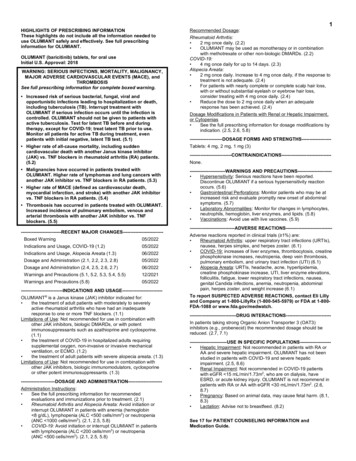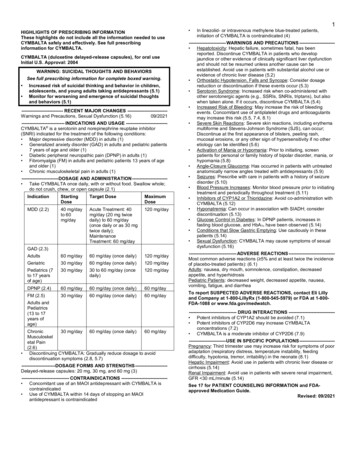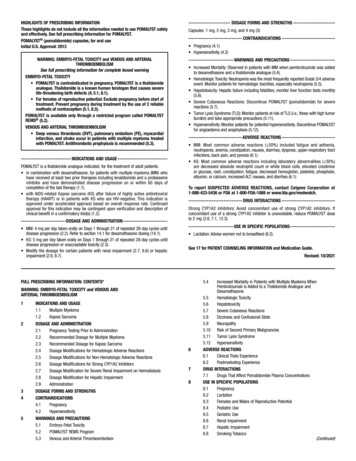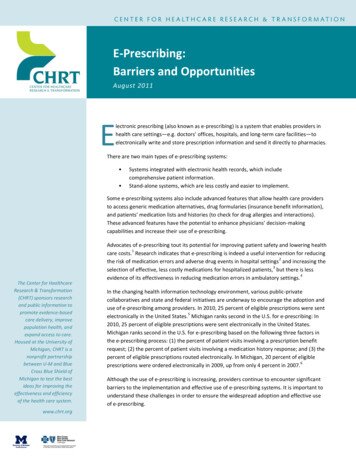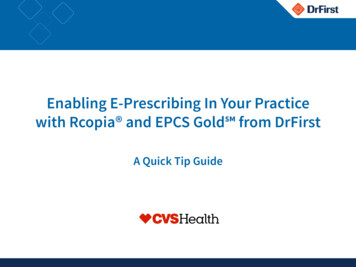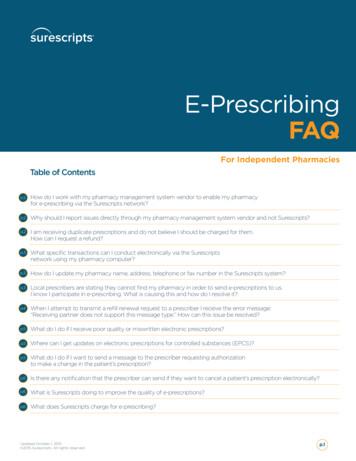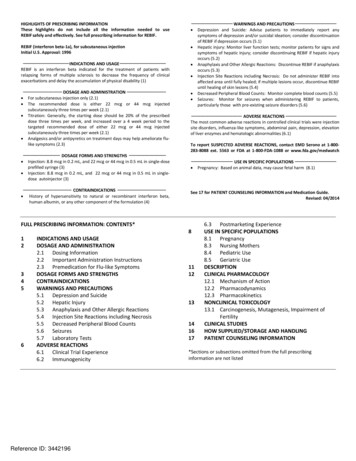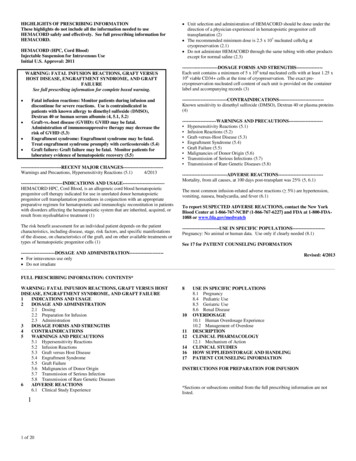
Transcription
HIGHLIGHTS OF PRESCRIBING INFORMATIONThese highlights do not include all the information needed to useHEMACORD safely and effectively. See full prescribing information forHEMACORD.HEMACORD (HPC, Cord Blood)Injectable Suspension for Intravenous UseInitial U.S. Approval: 2011WARNING: FATAL INFUSION REACTIONS, GRAFT VERSUSHOST DISEASE, ENGRAFTMENT SYNDROME, AND GRAFTFAILURESee full prescribing information for complete boxed warning. Fatal infusion reactions: Monitor patients during infusion anddiscontinue for severe reactions. Use is contraindicated inpatients with known allergy to dimethyl sulfoxide (DMSO),Dextran 40 or human serum albumin (4, 5.1, 5.2)Graft-vs.-host disease (GVHD): GVHD may be fatal.Administration of immunosuppressive therapy may decrease therisk of GVHD (5.3)Engraftment syndrome: Engraftment syndrome may be fatal.Treat engraftment syndrome promptly with corticosteroids (5.4)Graft failure: Graft failure may be fatal. Monitor patients forlaboratory evidence of hematopoietic recovery (5.5) --------------------------RECENT MAJOR CHANGES-------------------------Warnings and Precautions, Hypersensitivity Reactions (5.1)4/2013---------------------------INDICATIONS AND USAGE--------------------------HEMACORD HPC, Cord Blood, is an allogeneic cord blood hematopoieticprogenitor cell therapy indicated for use in unrelated donor hematopoieticprogenitor cell transplantation procedures in conjunction with an appropriatepreparative regimen for hematopoietic and immunologic reconstitution in patientswith disorders affecting the hematopoietic system that are inherited, acquired, orresult from myeloablative treatment (1)The risk benefit assessment for an individual patient depends on the patientcharacteristics, including disease, stage, risk factors, and specific manifestationsof the disease, on characteristics of the graft, and on other available treatments ortypes of hematopoietic progenitor cells (1) Unit selection and administration of HEMACORD should be done under thedirection of a physician experienced in hematopoietic progenitor celltransplantation (2) The recommended minimum dose is 2.5 x 107 nucleated cells/kg atcryopreservation (2.1) Do not administer HEMACORD through the same tubing with other productsexcept for normal saline (2.3)-----------------------DOSAGE FORMS AND STRENGTHS----------------Each unit contains a minimum of 5 x 108 total nucleated cells with at least 1.25 x106 viable CD34 cells at the time of cryopreservation. The exact precryopreservation nucleated cell content of each unit is provided on the containerlabel and accompanying records ---------------------------Known sensitivity to dimethyl sulfoxide (DMSO), Dextran 40 or plasma proteins(4)----------------------WARNINGS AND PRECAUTIONS--------------------- Hypersensitivity Reactions (5.1) Infusion Reactions (5.2) Graft-versus-Host Disease (5.3) Engraftment Syndrome (5.4) Graft Failure (5.5) Malignancies of Donor Origin (5.6) Transmission of Serious Infections (5.7) Transmission of Rare Genetic Diseases (5.8)-----------------------------ADVERSE REACTIONS----------------------------Mortality, from all causes, at 100 days post-transplant was 25% (5, 6.1)The most common infusion-related adverse reactions ( 5%) are hypertension,vomiting, nausea, bradycardia, and fever (6.1)To report SUSPECTED ADVERSE REACTIONS, contact the New YorkBlood Center at 1-866-767-NCBP (1-866-767-6227) and FDA at 1-800-FDA1088 or www.fda.gov/medwatch------------------------USE IN SPECIFIC POPULATIONS--------------------Pregnancy: No animal or human data. Use only if clearly needed (8.1)See 17 for PATIENT COUNSELING INFORMATION----------------------DOSAGE AND ADMINISTRATION--------------------- For intravenous use only Do not irradiateRevised: 4/2013FULL PRESCRIBING INFORMATION: CONTENTS*WARNING: FATAL INFUSION REACTIONS, GRAFT VERSUS HOSTDISEASE, ENGRAFTMENT SYNDROME, AND GRAFT FAILURE1INDICATIONS AND USAGE2DOSAGE AND ADMINISTRATION2.1 Dosing2.2 Preparation for Infusion2.3 Administration3DOSAGE FORMS AND STRENGTHS4CONTRAINDICATIONS5WARNINGS AND PRECAUTIONS5.1 Hypersensitivity Reactions5.2 Infusion Reactions5.3 Graft versus Host Disease5.4 Engraftment Syndrome5.5 Graft Failure5.6 Malignancies of Donor Origin5.7 Transmission of Serious Infection5.8 Transmission of Rare Genetic Diseases6ADVERSE REACTIONS6.1 Clinical Study Experience11 of 208101112141617USE IN SPECIFIC POPULATIONS8.1 Pregnancy8.4 Pediatric Use8.5 Geriatric Use8.6 Renal DiseaseOVERDOSAGE10.1 Human Overdosage Experience10.2 Management of OverdoseDESCRIPTIONCLINICAL PHARMACOLOGY12.1 Mechanism of ActionCLINICAL STUDIESHOW SUPPLIED/STORAGE AND HANDLINGPATIENT COUNSELING INFORMATIONINSTRUCTIONS FOR PREPARATION FOR INFUSION*Sections or subsections omitted from the full prescribing information are notlisted.
3132333435363738394041424344454647484950FULL PRESCRIBING INFORMATIONWARNING: FATAL INFUSION REACTIONS, GRAFT VERSUS HOST DISEASE,ENGRAFTMENT SYNDROME AND GRAFT FAILUREFatal infusion reactions: HEMACORD administration can result in serious, includingfatal, infusion reactions. Monitor patients and discontinue HEMACORD infusion forsevere reactions. Use is contraindicated in patients with known allergy to dimethylsulfoxide (DMSO), Dextran 40 or human serum albumin. [See Contraindications (4) andWarnings and Precautions (5.1, 5.2)]Graft-vs.-host disease (GVHD): GVHD is expected after administration of HEMACORD,and may be fatal. Administration of immunosuppressive therapy may decrease the risk ofGVHD. [See Warnings and Precautions (5.3).]Engraftment syndrome: Engraftment syndrome may progress to multiorgan failure anddeath. Treat engraftment syndrome promptly with corticosteroids. [See Warnings andPrecautions (5.4).]Graft failure: Graft failure may be fatal. Monitor patients for laboratory evidence ofhematopoietic recovery. Prior to choosing a specific unit of HEMACORD, consider testingfor HLA antibodies to identify patients who are alloimmunized. [See Warnings andPrecautions (5.5).]1INDICATIONS AND USAGEHEMACORD, HPC (Hematopoietic Progenitor Cell), Cord Blood, is an allogeneic cord bloodhematopoietic progenitor cell therapy indicated for use in unrelated donor hematopoieticprogenitor stem cell transplantation procedures in conjunction with an appropriate preparativeregimen for hematopoietic and immunologic reconstitution in patients with disorders affectingthe hematopoietic system that are inherited, acquired, or result from myeloablative treatment.The risk benefit assessment for an individual patient depends on the patient characteristics,including disease, stage, risk factors, and specific manifestations of the disease, on characteristicsof the graft, and on other available treatments or types of hematopoietic progenitor cells.2DOSAGE AND ADMINISTRATION For intravenous use only.Do not irradiate.Unit selection and administration of HEMACORD should be done under the direction of aphysician experienced in hematopoietic progenitor cell transplantation.2.1DosingThe recommended minimum dose is 2.5 x 107 nucleated cells/kg at cryopreservation. Multipleunits may be required in order to achieve the appropriate dose.2 of 20
0101Matching for at least 4 of 6 HLA-A antigens, HLA-B antigens, and HLA-DRB1 alleles isrecommended. The HLA typing and nucleated cell content for each individual unit ofHEMACORD are documented on the container label and/or in accompanying records.2.2Preparation for InfusionHEMACORD should be prepared by a trained healthcare professional. Do not irradiate HEMACORD.See the appended detailed instructions for preparation of HEMACORD for infusion.Once prepared for infusion, HEMACORD may be stored at 4 to 25 C for up to 4 hours ifDMSO is not removed, and at 4 C for up to 24 hours if DMSO is removed in a washingprocedure [see Instructions for Preparation for Infusion].The recommended limit on DMSO administration is 1 gram per kg body weight per day [seeWarnings and Precautions (5.2) and Overdosage (10)].2.3AdministrationHEMACORD should be administered under the supervision of a qualified healthcareprofessional experienced in hematopoietic progenitor cell transplantation.1. Confirm the identity of the patient for the specified unit of HEMACORD prior toadministration.2. Confirm that emergency medications are available for use in the immediate area.3. Ensure the patient is hydrated adequately.4. Premedicate the patient 30 to 60 minutes before the administration of HEMACORD.Premedication can include any or all of the following: antipyretics, histamineantagonists, and corticosteroids.5. Inspect the product for any abnormalities such as unusual particulates and for breachesof container integrity prior to administration. Prior to infusion, discuss all such productirregularities with the laboratory issuing the product for infusion.6. Administer HEMACORD by intravenous infusion. Do not administer in the sametubing concurrently with products other than 0.9% Sodium Chloride, Injection (USP).HEMACORD may be filtered through a 170 to 260 micron filter designed to removeclots. Do NOT use a filter designed to remove leukocytes.7. For adults, begin infusion of HEMACORD at 100 milliliters per hour and increase therate as tolerated. For children, begin infusion of HEMACORD at 1 milliliter per kg perhour and increase as tolerated. The infusion rate should be reduced if the fluid load isnot tolerated. The infusion should be discontinued in the event of an allergic reactionor if the patient develops a moderate to severe infusion reaction. [See Warnings andPrecautions (5.2) and Adverse Reactions (6).]8. Monitor the patient for adverse reactions during, and for at least six hours after,administration. Because HEMACORD contains lysed red cells that may cause renalfailure, careful monitoring of urine output is also recommended.3DOSAGE FORMS AND STRENGTHSEach unit of HEMACORD contains a minimum of 5.0 x 108 total nucleated cells with aminimum of 1.25 x 106 viable CD34 cells, suspended in 10% dimethyl sulfoxide (DMSO) and1% Dextran 40, at the time of cryopreservation.3 of 20
35136137138139140141142143144145146147148149The exact pre-cryopreservation nucleated cell content is provided on the container label and inaccompanying records.4CONTRAINDICATIONSHEMACORD is contraindicated in patients with known hypersensitivity to dimethyl sulfoxide(DMSO), Dextran 40 or plasma proteins. [See Description (11) and Dosage and Administration(2.2)]5WARNINGS AND PRECAUTIONS5.1Hypersensitivity ReactionsAllergic reactions may occur with infusion of HPC, Cord Blood, including HEMACORD.Reactions include bronchospasm, wheezing, angioedema, pruritus and hives [see AdverseReactions (6)]. Serious hypersensitivity reactions, including anaphylaxis, also have beenreported. These reactions may be due to dimethyl sulfoxide (DMSO), Dextran 40, or a plasmacomponent of HEMACORD.HEMACORD may contain residual antibiotics if the cord blood donor was exposed to antibioticsin utero. Patients with a history of allergic reactions to antibiotics should be monitored forallergic reactions following HEMACORD administration.5.2Infusion ReactionsInfusion reactions are expected to occur and include nausea, vomiting, fever, rigors or chills,flushing, dyspnea, hypoxemia, chest tightness, hypertension, tachycardia, bradycardia,dysgeusia, hematuria, and mild headache. Premedication with antipyretics, histamineantagonists, and corticosteroids may reduce the incidence and intensity of infusion reactions.Severe reactions, including respiratory distress, severe bronchospasm, severe bradycardia withheart block or other arrhythmias, cardiac arrest, hypotension, hemolysis, elevated liver enzymes,renal compromise, encephalopathy, loss of consciousness, and seizure also may occur. Many ofthese reactions are related to the amount of DMSO administered. Minimizing the amount ofDMSO administered may reduce the risk of such reactions, although idiosyncratic responses mayoccur even at DMSO doses thought to be tolerated. The actual amount of DMSO depends on themethod of preparation of the product for infusion. Limiting the amount of DMSO infused to nomore than 1 gram per kilogram per day is recommended [see Overdosage (10)].If infusing more than one unit of HPC, Cord Blood, on the same day, do not administersubsequent units until all signs and symptoms of infusion reactions from the prior unit haveresolved.Infusion reactions may begin within minutes of the start of infusion of HEMACORD, althoughsymptoms may continue to intensify and not peak for several hours after completion of theinfusion. Monitor the patient closely during this period. When a reaction occurs, discontinue theinfusion and institute supportive care as needed.4 of 20
2005.3 Graft-versus-Host DiseaseAcute and chronic graft-versus-host disease (GVHD) may occur in patients who have receivedHEMACORD. Classic acute GVHD is manifested as fever, rash, elevated bilirubin and liverenzymes, and diarrhea. Patients transplanted with HEMACORD also should receiveimmunosuppressive drugs to decrease the risk of GVHD. [See Adverse Reactions (6.1).]5.4Engraftment SyndromeEngraftment syndrome is manifested as unexplained fever and rash in the peri-engraftmentperiod. Patients with engraftment syndrome also may have unexplained weight gain,hypoxemia, and pulmonary infiltrates in the absence of fluid overload or cardiac disease. Ifuntreated, engraftment syndrome may progress to multiorgan failure and death. Begin treatmentwith corticosteroids once engraftment syndrome is recognized in order to ameliorate thesymptoms. [See Adverse Reactions (6.1).]5.5Graft FailurePrimary graft failure, which may be fatal, is defined as failure to achieve an absolute neutrophilcount greater than 500 per microliter blood by Day 42 after transplantation. Immunologicrejection is the primary cause of graft failure. Patients should be monitored for laboratoryevidence of hematopoietic recovery. Consider testing for HLA antibodies in order to identifypatients who are alloimmunized prior to transplantation and to assist with choosing a unit with asuitable HLA type for the individual patient. [See Adverse Reactions (6.1).]5.6Malignancies of Donor OriginPatients who have undergone HPC, Cord Blood, transplantation may develop post-transplantlymphoproliferative disorder (PTLD), manifested as a lymphoma-like disease favoring nonnodal sites. PTLD is usually fatal if not treated.The incidence of PTLD appears to be higher in patients who have received antithymocyteglobulin. The etiology is thought to be donor lymphoid cells transformed by Epstein-Barr virus(EBV). Serial monitoring of blood for EBV DNA may be warranted in high-risk groups.Leukemia of donor origin also has been reported in HPC, Cord Blood, recipients. The naturalhistory is presumed to be the same as that for de novo leukemia.5.7Transmission of Serious InfectionsTransmission of infectious disease may occur because HEMACORD is derived from humanblood. Disease may be caused by known or unknown infectious agents. Donors are screened forincreased risk of infection with human immunodeficiency virus (HIV), human T-celllymphotropic virus (HTLV), hepatitis B virus (HBV), hepatitis C virus (HCV), T. pallidum,T. cruzi, West Nile Virus (WNV), transmissible spongiform encephalopathy (TSE) agents, andvaccinia. Donors are also screened for clinical evidence of sepsis, and communicable diseaserisks associated with xenotransplantation. Maternal blood samples are tested for HIV types 1and 2, HTLV types I and II, HBV, HCV, T. pallidum, WNV, and T. cruzi. HEMACORD istested for sterility. There may be an effect on the reliability of the sterility test results if the cordblood donor was exposed to antibiotics in utero. These measures do not totally eliminate the riskof transmitting these or other transmissible infectious diseases and disease agents. Report the5 of 20
34235236237238239240241242occurrence of a transmitted infection to the New York Blood Center at 1-866-767-NCBP (1-866767-6227).Testing is also performed for evidence of donor infection due to cytomegalovirus (CMV). Testresults may be found on the container label and/or in accompanying records.5.8Transmission of Rare Genetic DiseasesHEMACORD may transmit rare genetic diseases involving the hematopoietic system for whichdonor screening and/or testing has not been performed [see Adverse Reactions (6.1)]. Cordblood donors have been screened by family history to exclude inherited disorders of the bloodand marrow. HEMACORD has been tested to exclude donors with sickle cell anemia, andanemias due to abnormalities in hemoglobins C, D, and E. Because of the age of the donor at thetime HEMACORD collection takes place, the ability to exclude rare genetic diseases is severelylimited.6ADVERSE REACTIONSDay-100 mortality from all causes was 25%.The most common infusion-related adverse reactions ( 5%) are hypertension, vomiting, nausea,bradycardia, and fever.6.1Clinical Trials ExperienceBecause clinical trials are conducted under widely varying conditions, adverse reaction ratesobserved in the clinical trials of a drug cannot be directly compared to rates in the clinical trialsof another drug and may not reflect the rates observed in practice.Infusion ReactionsThe data described in Table 1 reflect exposure to 442 infusions of HPC, Cord Blood, (frommultiple cord blood banks) in patients treated using a total nucleated cell dose 2.5 x 107/kg ona single-arm trial or expanded access use (The COBLT Study). The population was 60% maleand the median age was 5 years (range 0.05-68 years), and included patients treated forhematologic malignancies, inherited metabolic disorders, primary immunodeficiencies, and bonemarrow failure. Preparative regimens and graft-vs.-host disease prophylaxis were notstandardized. The most common infusion reactions were hypertension, vomiting, nausea, andsinus bradycardia. Hypertension and any grades 3-4 infusion-related reactions occurred morefrequently in patients receiving HPC, Cord Blood, in volumes greater then 150 milliliters and inpediatric patients. The rate of serious adverse cardiopulmonary reactions was 0.8%.6 of 20
Table 1: Incidence of Infusion-Related Adverse ReactionsOccurring in 1% of Infusions (The COBLT Study)Any gradeGrade 3-4Any .5%0.2%Nausea12.7%5.7%Sinus bradycardia10.4%0Fever5.2%0.2%Sinus 265266267268269270271272273274275276277Information on infusion reactions was available from voluntary reports for 244 patients whoreceived HEMACORD. The population included 56% males and 44% females with median ageof 25 years (range 0.2-73 years). Preparative regimens and graft-vs.-host disease prophylaxiswere not standardized. The reactions were not graded. An infusion reaction occurred in 18% ofpatients. The most common infusion reactions, occurring in 1% of patients, were hypertension(14%), nausea (5%), vomiting (4%), hypoxemia (3%), dyspnea (1%), tachycardia (1%), andcough (1%). The rate of serious adverse cardiopulmonary reactions was 0.1%.Other Adverse ReactionsFor other adverse reactions, the raw clinical data from the docket were pooled for 1299 (120adult and 1179 pediatric) patients transplanted with HPC, Cord Blood, (from multiple cord bloodbanks) with total nucleated cell dose 2.5 x 107/kg. Of these, 66% (n 862) underwenttransplantation as treatment for hematologic malignancy. The preparative regimens and graftvs.-host disease prophylaxis varied. The median total nucleated cell dose was 6.4 x 107/kg(range, 2.5-73.8 x 107/kg). For these patients, Day-100 mortality from all causes was 25%.Primary graft failure occurred in 16%; 42% developed grades 2-4 acute graft-vs.-host disease;and 19% developed grades 3-4 acute graft-vs.-host disease.Data from published literature and from observational registries, institutional databases, and cordblood bank reviews reported to the docket for HPC, Cord Blood, (from multiple cord bloodbanks) revealed nine cases of donor cell leukemia, one case of transmission of infection, and onereport of transplantation from a donor with an inheritable genetic disorder. The data are notsufficient to support reliable estimates of the incidences of these events.In a study of 364 patients, 15% of the patients developed engraftment syndrome.8USE IN SPECIFIC POPULATIONS8.1PregnancyPregnancy Category C. Animal reproduction studies have not been conducted withHEMACORD. It is also not known whether HEMACORD can cause fetal harm whenadministered to a pregnant woman or can affect reproduction capacity. There are no adequate7 of 20
and well-controlled studies in pregnant women. HEMACORD should be used during pregnancyonly if the potential benefit justifies the potential risk to the fetus.8.4Pediatric UseHPC, Cord Blood, has been used in pediatric patients with disorders affecting the hematopoieticsystem that are inherited, acquired, or resulted from myeloablative treatment. [See Dosage andAdministration (2), Adverse Reactions (6), and Clinical Studies (14).]8.5Geriatric UseClinical studies of HPC, Cord Blood, (from multiple cord blood banks) did not include sufficientnumbers of subjects aged 65 years and over to determine whether they respond differently thanyounger subjects. In general, administration of HEMACORD to patients over age 65 yearsshould be cautious, reflecting their greater frequency of decreased hepatic, renal, or cardiacfunction, and of concomitant disease or other drug therapy.8.6Renal DiseaseHEMACORD contains Dextran 40 which is eliminated by the kidneys. The safety ofHEMACORD has not been established in patients with renal insufficiency or renal failure.10OVERDOSAGE10.1 Human Overdosage ExperienceThere has been no experience with overdosage of HPC, Cord Blood, in human clinical trials.Single doses of HEMACORD up to 57.6 x 107 TNC/kg have been administered. HPC, CordBlood, prepared for infusion may contain dimethyl sulfoxide (DMSO). The maximum tolerateddose of DMSO has not been established, but it is customary not to exceed a DMSO dose of1 gm/kg/day when given intravenously. Several cases of altered mental status and coma havebeen reported with higher doses of DMSO.10.2 Management of OverdoseFor DMSO overdosage, general supportive care is indicated. The role of other interventions totreat DMSO overdosage has not been established.11DESCRIPTIONHEMACORD consists of hematopoietic progenitor cells, monocytes, lymphocytes, andgranulocytes from human cord blood for intravenous infusion. Blood recovered from umbilicalcord and placenta is volume reduced and partially depleted of red blood cells and plasma.The active ingredient is hematopoietic progenitor cells which express the cell surface markerCD34. The potency of cord blood is determined by measuring the numbers of total nucleatedcells (TNC) and CD34 cells, and cell viability. Each unit of HEMACORD contains a minimumof 5 x 108 total nucleated cells with at least 1.25 x 106 viable CD34 cells at the time ofcryopreservation. The cellular composition of HEMACORD depends on the composition ofcells in the blood recovered from the umbilical cord and placenta of the donor. The actual8 of 20
61nucleated cell count, the CD34 cell count, the ABO group, and the HLA typing are listed on thecontainer label and/or accompanying records sent with each individual unit.HEMACORD has the following inactive ingredients: dimethyl sulfoxide (DMSO) and Dextran40. When prepared for infusion according to instructions, the infusate contains the followinginactive ingredients: Dextran 40, human serum albumin, and residual DMSO.12CLINICAL PHARMACOLOGY12.1 Mechanism of ActionHematopoietic stem/progenitor cells from HPC, Cord Blood, migrate to the bone marrow wherethey divide and mature. The mature cells are released into the bloodstream, where somecirculate and others migrate to tissue sites, partially or fully restoring blood counts and function,including immune function, of blood-borne cells of marrow origin. [See Clinical Studies (14).]In patients with enzymatic abnormalities due to certain severe types of storage disorders, matureleukocytes resulting from HPC, Cord Blood, transplantation may synthesize enzymes that maybe able to circulate and improve cellular functions of some native tissues. However, the precisemechanism of action is unknown.14CLINICAL STUDIESThe effectiveness of HPC, Cord Blood, as defined by hematopoietic reconstitution, wasdemonstrated in one single-arm prospective study, and in retrospective reviews of data from anobservational database for HEMACORD and data in the dockets and public information. Of the1299 patients in the docket and public data, 66% (n 862) underwent transplantation as treatmentfor hematologic malignancy. Results for patients who received a total nucleated cell dose 2.5 x 107/kg are shown in Table 2. Neutrophil recovery is defined as the time fromtransplantation to an absolute neutrophil count more than 500 per microliter. Platelet recovery isthe time to a platelet count more than 20,000 per microliter. Erythrocyte recovery is the time to areticulocyte count greater than 30,000 per microliter. The total nucleated cell dose and degree ofHLA match were inversely associated with the time to neutrophil recovery in the docket data.9 of 20
8379380381Table 2: Hematopoietic Recovery for Patients Transplanted with HPC, Cord Blood, TotalNucleated Cell (TNC) Dose 2.5 x 107/kgThe COBLTDocket* andData SourceStudy*Public ctiveprospectiveNumber of patients3241299155Median age (years)4.67.014.5(range)(0.07 – 52.2)( 1 – 65.7)(0.2 – 72.6)59% male57% male54% maleGender41% female43% female46% femaleMedian TNC Dose (x 107/kg)6.76.44.9(range)(2.6 – 38.8)(2.5 – 73.8)(2.5 – 39.8)Neutrophil Recovery at Day 4276%77%83%(95% CI)(71% – 81%)(75% – 79%)(76% – 88%)Platelet Recovery at Day 100 of57%77%20,000/microliter (95% CI)(51% – 63%)(69% – 84%)Platelet Recovery at Day 100 of46%45%50,000/microliter (95% CI)(39% – 51%)(42% – 48%)Erythrocyte Recovery at Day 10065%(95% CI)(58% – 71%)Median time to Neutrophil27 days25 days20 daysRecoveryMedian time to Platelet Recovery90 days45 daysof 20,000/microliterMedian time to Platelet Recovery113 days122 daysof 50,000/microliterMedian time to Erythrocyte64 daysRecovery* HPC, Cord Blood (from multiple cord blood banks)16HOW SUPPLIED/STORAGE AND HANDLINGHEMACORD is supplied as a cryopreserved cell suspension in a sealed bag containing aminimum of 5 x 108 total nucleated cells with a minimum of 1.25 x 106 viable CD34 cells in avolume of 25 milliliters (NDC# 76489-001-01). The exact pre-cryopreservation nucleated cellcontent is provided on the container label and accompanying records.Store HEMACORD at or below -150 C until ready for thawing and preparation.17PATIENT COUNSELING INFORMATIONDiscuss the following with patients receiving HEMACORD: Report immediately any signs and symptoms of acute infusion reactions, such as fever, chills,fatigue, breathing problems, dizziness, nausea, vomiting, headache, or muscle aches. Report immediately any signs or symptoms suggestive of graft-vs.-host disease, includingrash, diarrhea, or yellowing of the eyes.10 of 20
15416417418419420421422423424425426427INSTRUCTIONS FOR PREPARATION FOR INFUSION1REQUIRED EQUIPMENT, REAGENTS, AND SUPPLIESEquipmentBiological Safety Cabinet (BSC)Refrigerated blood bank centrifugePlasma extractorDigital balanceTube sealer compatible with PVC plasticAutomated cell counterMicroscope and chamber for determining cell count and viability (optional)Water bath (4 liters or more)Canister opening toolOrbital RotatorReagents5% Albumin (human), USP10% Dextran 40, USPBacterial culture bottles (aerobic and anaerobic)SuppliesCell Wash/Infusion Bag Set (Transplant Set) (included with HEMACORD)Sterile Disposable Syringes: 3 mL, 30 mL and 60 mLSterile tubing18 gauge injection needlesSterile glovesHemostatsSterile small plastic zipper-lock bagsAlcohol prep padsIodine swab sticksSampling site couplersTubes for cell counts, progenitor assays (optional)Protective cryoglovesTransfer pack containers 300 mLInstructions for preparation for infusion2VERIFICATION OF PRODUCT IDENTITYHEMACORD is shipped frozen in a steel canister that is contained in an insulating foam sleeve.HEMACORD must be kept at or below -150 C, either inside the container used for shipping(Dry-Shipper) or in a Liquid Nitrogen (LN2)-cooled storage device at the Transplant Center(recommended).The bar-coded ID label of the product, affixed to the canister, is visible through the open side ofthe canister sleeve (Figure 1).11 of 20
428429430431432433434435436437438Figure 1a. Check the HEMACORD ID label to confirm its identity with the ID of the expectedproduct as soon as it is received.b. Wearing protective cryogloves, transfer the HEMACORD from the Dry-Shipper to thevapor phase of a LN2 storage tank.c.
HEMACORD HPC, Cord Blood, is an allogeneic cord blood hematopoietic The most common infusion-related adverse reactions ( 5%) are hypertension, progenitor cell therapy indicated for use in unrelated donor hematopoietic vomiting, nausea, bradycardia, and fever (6.1)

